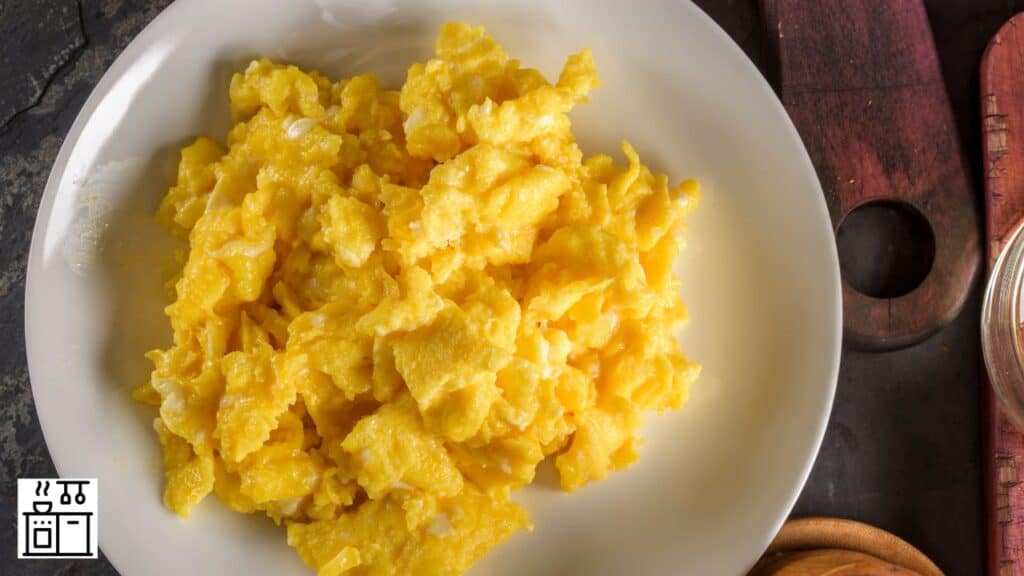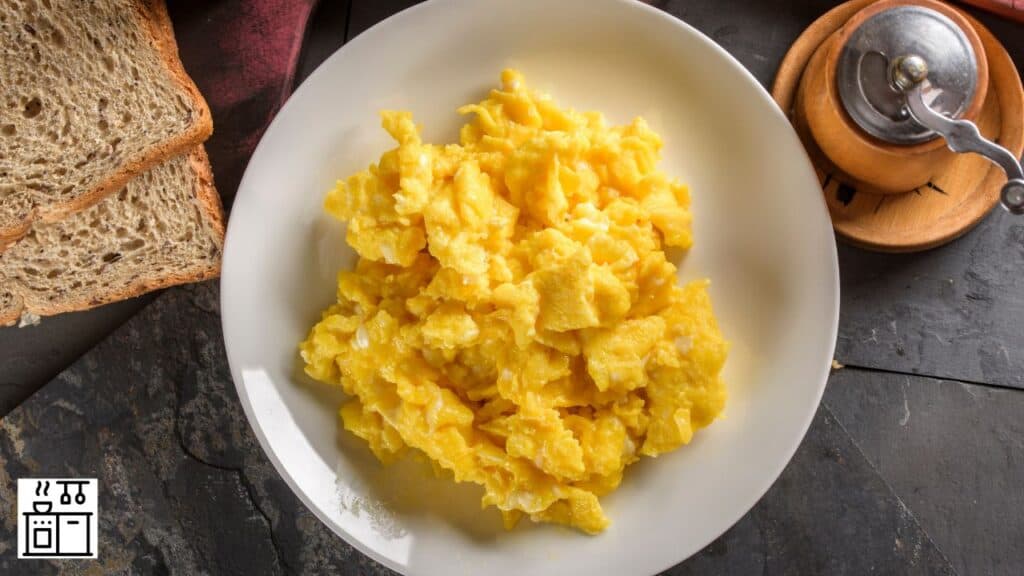Overcooked scrambled eggs are a result of cooking eggs too quickly or for an extended period, which causes the proteins within to overheat. This transforms the eggs into a tough, rubbery texture with a curdled, dry appearance, which is significantly different from the ideally soft and moist scramble.
Overcooked scrambled eggs also lose their appealing vibrant yellow color, turning pale and lackluster.
Cooking eggs over high heat can also lead to browning or burning, negatively impacting the overall taste.
What Are the Characteristics of Overcooked Scrambled Eggs?
When you’re dealing with overcooked scrambled eggs, they’ll often look dry and curdled, feel rubbery to the touch, and won’t taste quite right.
You’ll notice they’ve lost their vibrant yellow color, appearing pale and less appealing. This is due to the proteins in the eggs overheating and undergoing changes that affect their appearance.
You might also be taken aback by the texture. The scrambled eggs are no longer soft and fluffy. Instead, they’re tough and chewy, similar to rubber.
Overcooking causes the eggs to dehydrate and shrink, leaving them dry. You’ll also notice that the eggs seem to have steamed rather than sautéed, adding to that rubbery texture that’s far from appetizing.
But perhaps the most disappointing characteristic of overcooked scrambled eggs is the taste. The joy of eating is not just about the food’s appearance or texture but mainly its flavor.
Overcooking not only affects the eggs visually and texturally, but it also hampers the overall taste. If you cook eggs over high heat, they can brown or even burn, negatively impacting their flavor.
Remember, the key to perfect scrambled eggs lies in low heat and patience. Don’t rush the process, and you’ll be rewarded with delicious, fluffy, and moist scrambled eggs.
What Are the Causes of Overcooked Scrambled Eggs?
Overcooking scrambled eggs can easily happen, but understanding the causes can help prevent this common kitchen mishap.
Given below are the causes of overcooked scrambled eggs:
- High Heat: High heat is a common culprit. It can cause your eggs to cook too quickly, leading to a rubbery texture and undesirable browning or even burning. Always remember, it’s about patience, not speed. Low and slow wins the egg scramble race.
- Excessive Liquid: If you’re adding too much liquid, you’re setting yourself up for a watery, overcooked, and flavorless dish. The excess liquid causes the eggs to steam instead of sauté, which can result in a rubbery texture and a pale, unappealing color.
- Prolonged Cooking Time: Timing is everything in cooking, and eggs are no exception. Leaving them in the pan for a few seconds too long can result in an overcooked, dry, and rubbery consistency.
- Neglecting Residual Heat: You must also account for the residual heat. Even after you’ve removed the pan from the stove, it’s still hot enough to continue cooking your eggs, potentially overcooking them.
Understanding and avoiding these common mistakes can significantly improve your scrambled eggs.
What Are the Effects of Overcooked Scrambled Eggs on Taste and Texture?

Overcooked scrambled eggs can have several negative effects that you might not be aware of.
The taste is one of the first things that gets affected when scrambled eggs are overcooked.
Using high heat can brown or even burn your scrambled eggs, altering their taste and making them look less appealing.
Also, if there’s excess liquid in your pan, it can dilute the flavor of your eggs, leaving them tasting bland and unappetizing.
The next thing that gets affected is the texture of scrambled eggs.
Overcooking scrambled eggs can easily make them dry and develop a gummy feel.
When proteins in the eggs are overheated, they become tough and rubbery. This shrinking from dehydration is why overcooked scrambled eggs appear curdled and feel dry.
If you add too much liquid in an attempt to keep them moist, you’ll end up with a rubbery texture since the excess liquid causes the eggs to steam instead of sauté.
The appearance of your scrambled eggs can also suffer greatly from overcooking.
They lose their vibrant yellow color, becoming pale and unattractive. Browning or burning due to high heat also negatively impacts their visual appeal.
Tips for Making Perfect Scrambled Eggs
Making perfectly scrambled eggs that are creamy, fluffy, and bursting with flavor is possible. All it takes is a little know-how, the right tools, and a bit of patience.
First, let’s get your equipment sorted. A nonstick pan is your best friend when it comes to scrambled eggs. It’ll keep those precious yolks from sticking and ensure an even, easy cooking process.
A silicone spatula, gentle and sturdy, will be your go-to for stirring and folding your eggs to that ideal consistency.
Now, onto the eggs themselves. Forget about the milk and cream, they’re just diluting your flavor and turning your eggs into a watery mess.
Instead, opt for a spoonful of sour cream, crème fraiche, or Greek yogurt to whisk into your raw eggs. This will give you the fluffiness and tenderness you’re aiming for.
Here are the steps to make perfect scrambled eggs:
- Crack your eggs into a bowl, not directly into the pan, and whisk until the yolks and whites are well mixed.
- Cook your eggs over low-to-medium heat, stirring frequently. If you want to make cheesy scrambled eggs, add the cheese about halfway through the cooking process.
- Remove the scrambled eggs from the heat just before they’re fully cooked. The residual heat in the pan will finish the job. But if you remove them too early, the scrambled eggs will be undercooked.
- Season your scrambled eggs with salt and pepper at the end of cooking to avoid over-seasoning.

